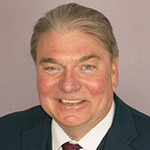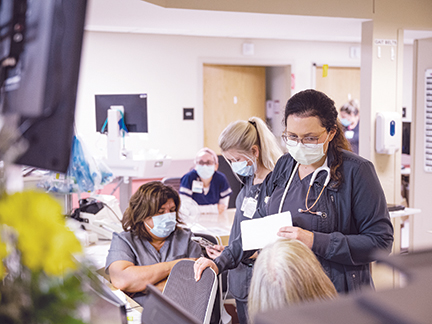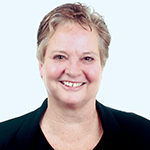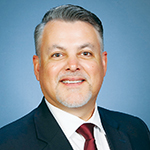By JULIE MINDA
Research has shown that rural populations in the U.S. have health vulnerabilities that set them at higher risk of shortened lives, as compared with their suburban and urban counterparts.
Three executives who run Catholic hospitals in rural communities fear the health status of the populations they serve could worsen because many people are more reticent to seek in-person care than they were before the pandemic, perhaps fearing COVID-19
contagion or the cost of obtaining care.
Divining new approaches to address these and other challenges is a priority.

Lloyd
Donald H. Lloyd II is president and chief executive of St. Claire HealthCare in Morehead, Kentucky. With 159 beds, St. Claire is the largest rural hospital in Eastern Kentucky. Lloyd said rural facilities like St. Claire "are so important to the communities
they serve." He noted that, like many other rural hospitals across the U.S., St. Claire was founded to be a safety net hospital and continues that mission to today.
Currently, about 80% of its patients are insured under Medicaid or Medicare. "We have very narrow margins, and we are under constant financial strain, but we can pay the bills, and we meet the needs of our population," said Lloyd.
Sicker
According to a CHA policy brief, rural hospitals
and health facilities confront the challenge of serving an increasingly vulnerable and diverse community stretched across a wide geographic service area, while also facing staffing shortages.

PeaceHealth Ketchikan Medical Center is a critical access hospital located in a county of about 13,700 people in southeast Alaska. Rural hospitals care for populations of people who are at greater risk for poor health as compared with people in suburbs
or cities.
The increased need coupled with the rising cost and challenge of operating a hospital and other health care facilities in a rural community have "left health care providers with difficult choices," such as discontinuing services or closing sites, the
white paper said. Exacerbating the situation are the decreasing investments in rural health infrastructure generally and a health care reimbursement scheme that is incompatible with the exigencies of providing care in rural areas.
The National Rural Health Association said in its 2022 Policy Agenda that the pandemic
has ravaged rural practices financially, disrupted rural economies and eroded care access, creating what that association calls "medical deserts."
The CHA brief said rural communities have higher rates of suicide, smoking and obesity, and less access to healthy food options than urban and suburban areas. Rural dwellers are more likely than urbanites to die prematurely of heart disease, cancer, unintentional
injury, chronic lower respiratory disease and stroke. CHA's analysis is based on data from the Centers for Disease Control and Prevention.
Technology bridge
The ministry hospital executives interviewed for this article said while they expanded telehealth capacity during the pandemic more infrastructure expansion work is needed.

Frontline staff work in one of St. Claire HealthCare's medical-surgical nursing units. The integrated health system is based in Morehead, Kentucky, an Appalachia community of about 7,000 people. Many in its 11-county service area struggle with socioeconomic
stressors and health care access.
When COVID-19 shut down — or significantly decreased access to — in-person care, the federal government provided money to expand telemedicine technology by building broadband infrastructure. This comes on top of significant gains that have been made in
broadband coverage in rural areas in the past decade. Nevertheless, rural patients are considerably less likely than city dwellers to have broadband service at home that would support telemedicine appointments via video. According to a Pew Research Center survey in early 2021, seven in 10 rural Americans have a home broadband connection.
Fast ramp-up
Nestled in the foothills of the Appalachians, St. Claire developed a creative work-around early in the pandemic when it found that many community members did not have the broadband connections at home that they needed
to link with St. Claire's clinicians online.
St. Claire established mobile hotspots in parking lots at its Morehead medical pavilion and four of St. Claire's rural clinics and invited patients there. St. Claire staff went to patients' cars with iPads to facilitate patients' visits with physicians
and other clinicians.
Additionally, St. Claire provided telemedicine care to COVID patients recuperating at home after a hospital visit. Through the COVID Care at Home program, patients with moderate symptoms of COVID were discharged from the emergency department with medications
and medical equipment to manage their condition from home. St. Claire's postacute care team managed their care through virtual appointments, phone calls and access to on-call providers.
Retaining gains
Dori Stevens, chief administrative officer of PeaceHealth Ketchikan Medical Center in Alaska, said it was because payers allowed for the reimbursement of telemedicine that rural providers were able to use technology
so much to patients' advantage. PeaceHealth is advocating to retain those allowances, so providers can build upon their progress.

Stevens
In its rural health policy brief, CHA said it supports the "continuation of the telehealth flexibilities and financing provided during the COVID-19 pandemic as well as increased investments in broadband and point-of-service telehealth technologies to
ensure greater access to care especially for individuals living in rural areas."
Clay O'Dell, a CHA director of advocacy, said not only is it important for government agencies to make permanent the emergency authorizations that allowed telehealth to thrive during the pandemic — it also is important for those agencies to allow for
flexibility on the part of providers. He said there are various types of technology that health care providers have been using to increase access to care for patients, including teleconferencing, Skyping, telephone service and texting. He said all
of these can be valuable links between providers and patients, and reimbursement policies should reflect that.
'Choosing rent over medicine'
But even the best technology will be useless if people are not trying to access care.

Miller
Dr. Bryan Miller is physician executive with Franciscan Missionaries of Our Lady Health System and interim president of FMOLHS' Northshore market, which includes Our Lady of the Angels Hospital in Bogalusa, Louisiana. He said Our Lady of the Angels has
seen a disturbing decrease in people accessing care, and it also has seen an increase in concerns related to hunger, housing and employment.
Miller believes these phenomena of decreased care seeking and increased personal struggles are interrelated. "My biggest concern is that overall volumes are softening, we're not seeing the same volumes as pre-COVID, perhaps because of the financial strains
in the country. I believe people are choosing rent over medicine."
He said he is concerned people may not be coming to appointments because they can't afford gas. "Appointment no-shows are over 20% in the outpatient environment and climbing. Our parish is very impoverished, and telemedicine is not working for everyone.
So, we're doing all we can to make sure that financial issues are not a reason people are staying home."
To address the concerns, Our Lady of the Angels opened a seven-day-a-week urgent care clinic and plans to open two more.
It also has created a "clinician care partners" team that follows up with patients with pronounced socioeconomic challenges and helps address those concerns. For instance, they ask if the patient has reliable transportation and problem-solves if the person
does not. Our Lady of the Angels has been expanding its partnerships with local social service agencies to provide aid to patients in need.
St. Claire in Appalachia also has seen a falloff in use of outpatient care. Outpatient visits dropped by 35% in the initial stages of the pandemic. While visits are returning to prepandemic levels, "we still see very acute clinical conditions as a result
of patients delaying care," Lloyd said. St. Claire is starting a marketing campaign to try to convince them to return.
Lloyd said St. Claire and other rural providers are engaged in critical work. The community members that rural providers care for are very often poor, marginalized and disenfranchised from the socioeconomic resources that people in suburban and urban
areas enjoy.
Prioritizing health care access to rural populations is essential to the ministry's mission to promote health equity and continue to care for the poor and vulnerable, Lloyd said.
_____________
Further reading:
Rural hospitals make contingency plans to account for, limit vulnerabilities
April – May, 2020
Rural hospitals work to stave off financial hit of pandemic
July 1, 2020
Staffing, cost concerns continue to vex rural facilities
The health care infrastructure is fragile in many rural communities, and that puts at risk the well-being of many of the approximately 46 million Americans who live in rural areas, according to the National Rural Health Association.
Several ministry executives heading rural facilities said that while their sites have remained stable, they have concerns about the potential impact of staffing shortages and rising costs. They said that innovation, collaboration and government aid are key to protecting rural health care.
Not enough hands
Staffing issues have plagued virtually all other health care providers, but recruiting clinicians to rural areas adds several degrees of difficulty to filling open slots. It is very difficult to lure clinicians to small communities and to match the pay rates of large urban and suburban facilities.
Maintaining staffing has been a chronic challenge for rural facilities and the concerns have become acute since 2020. Dori Stevens, chief administrative officer, PeaceHealth Ketchikan Medical Center, Ketchikan, Alaska, said shortages are worst among the nursing staff. That rural hospital also is struggling to fill numerous other clinical and nonclinical roles.
Stevens said some staffing agencies that supply traveling nurses and other clinicians to rural hospitals in Alaska are charging triple what they commanded before the pandemic.
To compete, Ketchikan Medical has increased its own clinician pay scales. It's offering referral bonuses.
As a long-term hiring strategy, it has increased its collaborations with Alaskan schools and universities. This includes helping the schools develop new educational programs and recruiting program graduates.
Donald H. Lloyd II, president and chief executive of St. Claire Healthcare, in Morehead, Kentucky, said staff nurses have left hospital jobs in droves during the pandemic to take high-paying travel nursing jobs.
Nurses and doctors have retired or otherwise given up clinical care having endured crushing work hours and trauma from the magnitude of death and human suffering they've witnessed over the past two-plus years of the pandemic.
St. Claire in Kentucky has lost about 15% of its nurse workforce since the start of the pandemic. Lloyd said the facility has been using state and federal dollars, including from pandemic-era aid packages, to try to build back its staff. It has hired 60 new graduates of nursing programs during the pandemic and recruited 19 physicians this year.
Dr. Bryan Miller is physician executive with Franciscan Missionaries of Our Lady Health System and president of FMOLHS' North Shore market. He said Our Lady of the Angels Hospital in Bogalusa, Louisiana, gave a 2% salary increase to all staff and have since followed up with multiple rounds of appreciation and loyalty bonuses. It has maintained merit pay increases at a time when many organizations froze salaries, said Miller.
Our Lady of the Angels also has developed a program to help licensed practical nurses become registered nurses.
FMOLHS and the hospital joined with five other southeastern Louisiana health systems to form Northshore Healthscape, a regional collaborative working on staffing concerns. Health care employers are struggling to find enough workers now and estimates are that by 2026 the number of health care jobs in the region will grow by 11%.
The group is conducting an in-depth health care infrastructure assessment. And it's partnering with the local Northshore Technical Community College to strengthen academic training for health care workers. A goal is to keep more young people closer to home with good jobs that give them a great sense of purpose, Miller said.
Perpetual dilemma
While the rural facilities have benefited from the infusion of government dollars during the pandemic, they've exhausted much of that funding and are feeling the pinch once again of reimbursement shortfalls, the executives said.
According to a CHA rural health policy brief, with Medicare and Medicaid each paying less than 90 cents for every dollar hospitals spend on caring for a patient, rural facilities that serve a high proportion of patients insured under these programs can quickly lose financial ground. The brief said, "With rural hospitals forced to meet minimum staffing and service needs to serve a smaller, often older, and poorer populations, reimbursement rates should be updated to reflect the cost or providing healthcare in rural communities."
Stevens said rural hospitals normally do not have the volumes to secure enough revenue to pay for the baseline costs of running their facilities. While rural health reimbursement formulas try to correct for this imbalance, reimbursement still does not cover actual costs of running a facility and providing care. One of the reimbursement formulas used to account for the imbalance is the Medicare Disproportionate Share Hospital formula, through which Medicare provides enhanced payments to hospitals serving a significantly disproportionate number of low-income patients.
Stevens said inflation in goods and labor rates has widened the gap between reimbursement and expenditures. She noted Ketchikan Memorial relies on oil for heating and air conditioning, and the cost of oil nearly doubled earlier this year.
St. Claire's Lloyd said of the inflation overhang: "We feel like we just managed COVID and now we're managing a new crisis."
The executives said they are engaged in state and federal advocacy for continuing aid, particularly around raising rural facilities' Medicaid and Medicare reimbursements and around increasing the pipeline of workers for rural facilities.
— JULIE MINDA